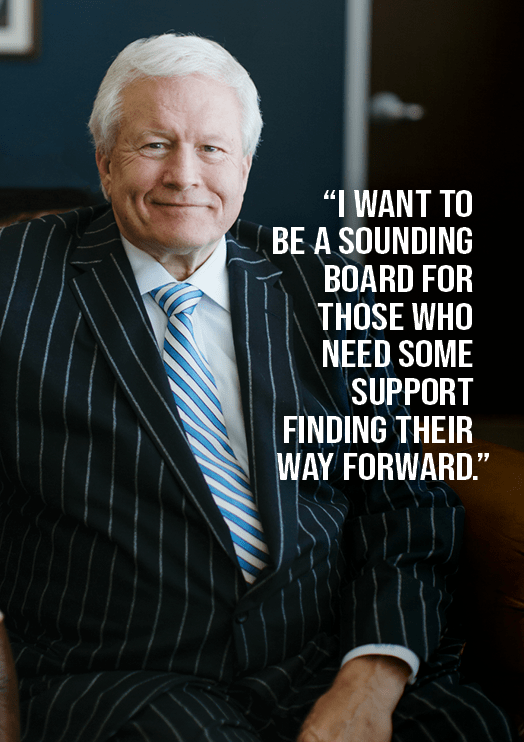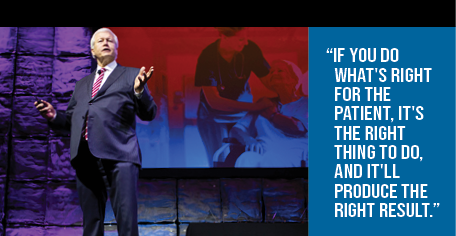On a summer night in 2013, Ted Shaw found himself cleaning out freezers at Parkland Health & Hospital System to prepare for final inspections from state and federal regulators.
It was an unlikely spot for a high-ranking hospital CFO, but the stakes were high, and Shaw was not shy about getting into the trenches, especially if it benefited patients.
When Shaw joined as the interim executive vice president and chief financial officer, Parkland was out of compliance with several patient-safety-related standards and faced the threat of closure almost daily. If the issues continued to go unresolved, Parkland stood to lose its crucial Medicare and Medicaid funding, leaving vulnerable patient populations in Dallas without access to care.
“The night before the third and final inspection, all of us pitched in,” Shaw recalls. “We were scraping out freezers and cleaning grease off appliances, but we did it. And when they came back to reinspect us, we were given the thumbs-up, and we were released from Armageddon so to speak. It was fantastic.”
On Aug. 7, 2013, after nearly two years of overhauling its patient-safety practices, CMS released Parkland from its systems improvement agreement, ensuring Dallas County residents would have access to critical health care services. Today, Parkland is one of the busiest hospitals in the nation, with over one million patient visits a year and a new 2.8 million-square-foot medical campus.

“I know Ted was the right CFO at the right time for Parkland,” says Debbie Branson, former Parkland board chairwoman. “I will be eternally grateful that he stood by my side during those times.”
Known as an adept “turnaround” expert, Shaw had been brought in to help solve Parkland’s problems – a skill he had sharpened in numerous hospitals over the course of his decades-long career.
His next and final calling was to the Texas Hospital Association, where he took the reins as president and CEO eight years ago and is poised to retire at the end of the year.
Becoming a Partner
Health care is in Shaw’s DNA. He grew up hearing stories about his late grandfather’s work as a physician and the care he provided to his community in Washington. These stories piqued Shaw’s interest in pursuing a medical degree too. However, after an accelerated course in equivalent chemistry at Dartmouth, Shaw decided to pursue a business degree instead. He left Dartmouth for the University of Texas at Austin, where he received his undergraduate degree in accounting and went on to work for one of the Big Four accounting firms, Ernst & Young (formerly Ernst & Ernst).
“Right out of college, I started working for Ernst & Ernst and lo and behold the first job I had was to go work in a small hospital helping with their audit and cost report,” Shaw recalls. “And I kept going back to these health care jobs because unlike other industries where accountants are viewed as a necessary evil, I felt like I was a partner. I felt needed and valued.”
From there, Shaw found his calling and received the opportunity to traverse Texas while helping hospitals improve their bottom line. This began his lifelong education on the unique and universal challenges Texas hospitals face.
“The travel was fun. I roamed the state of Texas — literally — from College Station to El Paso. We developed a team of people who worked together on hospitals and health care organizations, and we weren’t just doing compliance or finance audits. We were helping them build their budgets and improve their reimbursements.”
Working hand-in-hand with hospital executives and employees was Shaw’s way of practicing medicine. Early on, he found a winning formula that still hangs directly across from his desk as a reminder to himself and everyone who enters that reads, “If it’s right for the patient, it’s the right thing to do.”
“What I have found with regards to any type of hospital, whether it be a for-profit hospital or a not-for-profit hospital, if you do what’s right for the patient, it’s the right thing to do, and it’ll produce the right result.”
As he partnered with health care leaders across the state to improve their hospitals’ financial outcomes, Shaw achieved his first major professional milestone: making partner at Ernst & Young.
A Turnaround Leader
While being a consultant had its advantages, the role lacked the position and resources needed to actually implement and effect change on behalf of patients.
“I’d write a consulting report, issue it, and a year later I would come back and find it on someone’s bookshelf and that’s as far as it got. This really motivated me into hospital operations. I wanted to take those ideas and see them through to fruition.”
Shaw’s dedication to making change transcended the bounds of Texas. He took the best practices he acquired in over 25 years of consulting work and became an adept turnaround leader in various health care executive roles throughout the country.
One of his first major turnarounds transpired twice at East Jefferson General Hospital in New Orleans. As the interim chief financial officer, Shaw spent 18 months redesigning their financial organization and led a $30 million operating turnaround for the hospital, then had to return one month after Hurricane Katrina.
“We spent 18 months fixing the hospital, turned it over to permanent management and left. Then one month after Katrina, resource challenged re-emerged, and they called me back for a second turnaround.”
Shortly after Shaw navigated East Jefferson General Hospital through the financial aftermath of Hurricane Katrina, the Jackson Health System in Miami called him to assist in one of the biggest financial turnarounds of his career.
When Shaw joined as the chief transition officer, The Miami-Dade Hospital District lost $350 million the year prior and had about four days of cash-on-hand. Shaw spent about two hours every day figuring out how employees and vendors were going to get paid.
“By the time I left, we improved the revenue cycles so there was 30 days of cash on hand and had a breakeven margin,” says Shaw. “Which is a lot coming from a $350 million deficit. It was a big financial turnaround.”
Bringing Texas Hospitals Together
Shaw was attracted to the CEO role at THA because he saw an opportunity to bring Texas hospitals together. He knew the optics tended to favor large health systems, but he understood how important each hospital is in its community from his early consultancy years.
“The big guys are important, but so are the little guys and so are the children’s hospitals and other specialty hospitals. We had to find a way to unite us all and move forward.”

Inclusion is imperative to Shaw. In addition to expanding advocacy efforts to include all types of hospitals and health care systems, Shaw prioritized efforts that emphasized diversity, equity and inclusion within health care. The pandemic, coupled with national protests against racism, highlighted the inequities that exist in the nation’s health care system. Under Shaw’s leadership, THA created an internal Diversity, Equity and Inclusion Committee that educates staff on the importance of diversity in the workplace and identifies growth opportunities.
Additionally, under the leadership of Shaw and the 2021 board chairman, Marc Boom, M.D., FACHE, THA created its Executive Committee on Diversity, Health Equity and Inclusion. The committee consists of health care leaders from a variety of Texas hospitals who work together to continually identify inequities in health care delivery.
The lifelong consultant in Shaw also heightened operational efficiency for the organization. In eight years, THA transformed into a process-oriented organization in pursuit of the Baldrige National Quality Award — the highest level of national recognition for performance excellence that a U.S. organization can receive. Under Shaw’s leadership, THA modernized programs, pursuing new technologies, expanded educational opportunities and stayed on the cutting edge of innovations and communications to ultimately benefit hospitals and the patients they serve.
Piece by Piece
When asked to recall the most significant challenges in health care that he saw during his career, Shaw chuckles. “As long as I can go in reverse chronological order.”
“There has been no health care challenge greater than working in this COVID-19 environment because of the drain on resources, especially on human capital,” Shaw says. “Unlike a hurricane, everyone in the state, country and world were looking for the same resources at a time when supplies were not accessible.”
The global pandemic put the work of hospitals and health care workers in the spotlight. And most recently, Texas’ notoriously challenging political landscape made a for an interesting legislative session, following by three special sessions. During this time, Shaw championed advocacy efforts to dismantle Medicaid Fiscal Accountability Rule, extend the Medicaid 1115 Waiver and expand health care coverage for uninsured Texans. Even in his last months at the helm, Shaw kept THA at the forefront of the conversation surrounding COVID-19 vaccine mandates for employers, insisting that hospitals should retain the right to mandate vaccines.
“Over the past eight years, and especially since the pandemic struck our lives, Ted has managed Texas-sized challenges with a passion, caring and commitment of equal size,” says Rick Pollack, president and CEO of the American Hospital Association. “He has demonstrated what a strong state association can do, and it has been an honor and privilege to be a partner with him in serving Texas hospitals and health systems.”
“I think our best example of success was how the THA team performed through the pandemic in terms of advocating for our members, being there for them and communicating with them,” Shaw says. “And I know we’ve been an example for other state hospital associations to follow.”
His advice for health care leaders who remain on the front lines of the pandemic: approach your problems piece by piece and prioritize issues rather than taking on the pandemic as a whole. “And, of course, always do what’s right for the patient.”
The Road Ahead
The decision to retire is a difficult one, particularly for a CEO. When times are tough, they can’t leave. And when times are good, they don’t want to leave. Getting the timing right is essential, a responsibility that Shaw took to heart. His original plan was to retire in the summer of 2021, but he dutifully remained to ensure THA was well out of the 2021 legislative session and the subsequent special sessions before leaving.
“I’ll hate leaving, but by the same token I’ve seen my grandkids twice in two years, and that’s just not enough. I really look forward to spending time with my wife. Although I used to spend 60 to 80% of my time on the road, so I hope I don’t get in her way,” Shaw jokes.
While he’s looking forward to spending lots of time with family and getting back to traveling, Shaw’s passion for partnering with hospitals will remain with him forever. Those who will miss his sound advice on operational best practices, leadership or advocacy don’t need to worry. His retirement plans also include advising fellow health care leaders who need a listening ear.
“I’d love to be that friend who colleagues can bounce ideas off. I want to be a sounding board for those who need some support finding their way forward,” says Shaw.
“My door is always open — just with slightly different hours of operation.”
